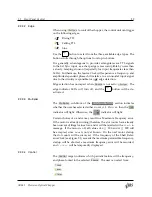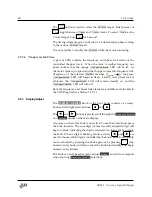
16
1 Getting Started
8. Adjust the lock‑in sensitivity until a signal is visible.
The lock‑in is measuring the component of the photodiode signal
at the frequency provided by the
Outer Slots Ref Out
. This signal is
produced by the taller opto‑interrupter at the base of the chopper
head. Because the photodiode is at a different position from the
interrupter, there will be a phase difference of
𝜙
detector
= 𝑛×360°+
𝜙
offset
, where
𝑛
is the integer number of slots between the opto‑
interrupter and the photodiode.
In most cases it is desirable to adjust for
𝜙
offset
(the
𝑛 × 360°
term
can be neglected). This can be achieved by adjusting the phase on
the lock‑in.
9. Adjust the phase of the lock‑in so that the entire signal appears on
the first channel (Ch 1 or
𝑋
on most two‑phase lock‑ins). On the
SR860 lock‑in, simply press
Auto
Phase
.
The phase difference between the photodetector and the opto‑
interrupter signals is a result of the relative physical positions of
those detectors around the chopper blade and cannot be adjusted
by a setting on the SR542. Increasing the phase setting of the
SR542 does advance the phase of the photodetector signal, but it
advances the phase of the opto‑interrupter signal—used by the
lock‑in as its reference—by an identical amount.
10. Set the
Phase
of the SR542 to 15
°
and notice that the signal on the
lock‑in does not change.
11. Set the
Phase
of the SR542 to 0
°
.
12. Now disconnect the BNC cable from the
Outer Slots Ref Out
and
connect it instead to the
Source Output
.
The phase of the lock‑in signal is now offset by the phase differ‑
ence between the
Source Output
and the opto‑interrupter.
13. Change the
Phase
of the SR542 and notice that the same change
appears on the lock‑in.
Source Output
provides a signal with the same average frequency as the
selected
Control
track and its corresponding rear panel output (
Outer
Slots Ref Out
or
Inner Slots Ref Out
), so long as the
Multiplier
is set for
×
1
. However, the signals produced by the opto‑interrupters (
Outer
Slots Ref Out
and
Inner Slots Ref Out
) are the most accurate representa‑
tions of the modulation imposed on a beam path through the outer and
inner tracks, respectively. Therefore, it can be advantageous to use these
outputs as the lock‑in reference input.
SR542 Precision Optical Chopper
















































